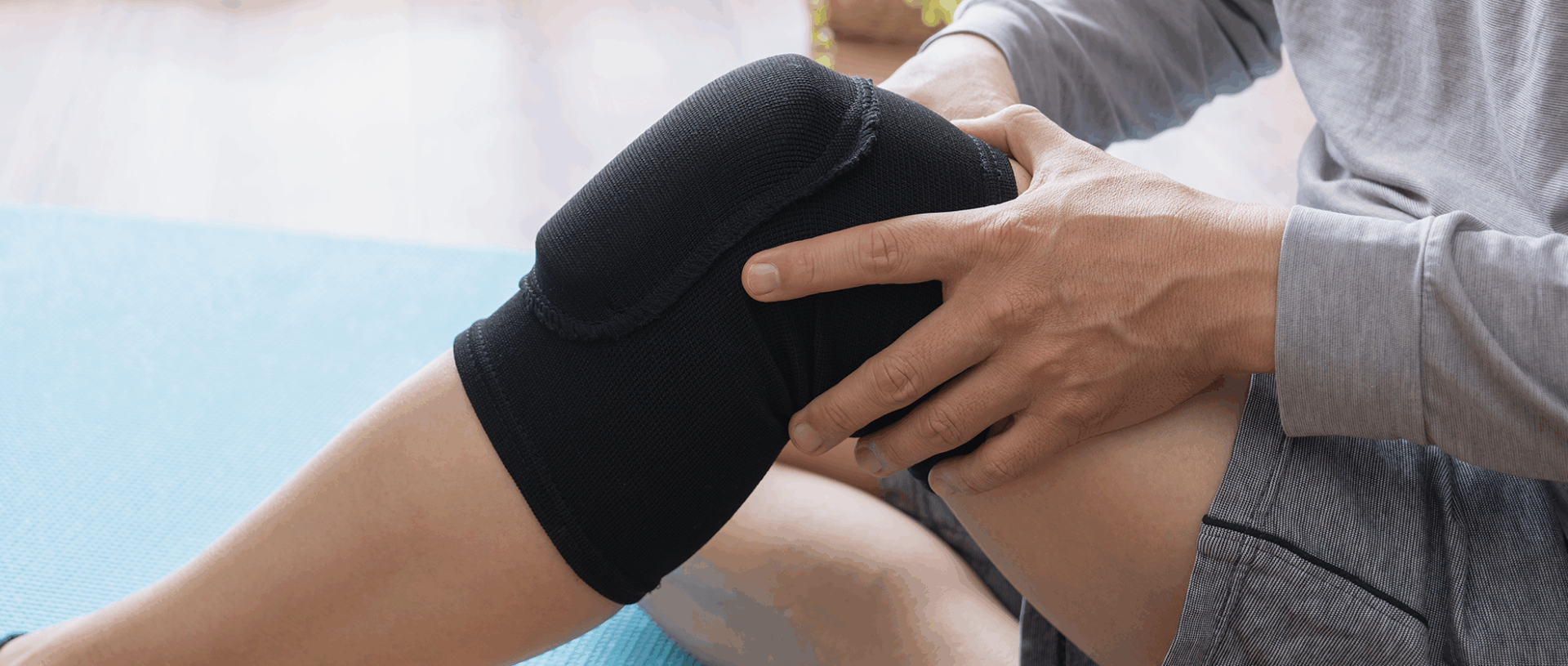Nutritional and Herbal Interventions for Musculoskeletal Health
Musculoskeletal System Overview
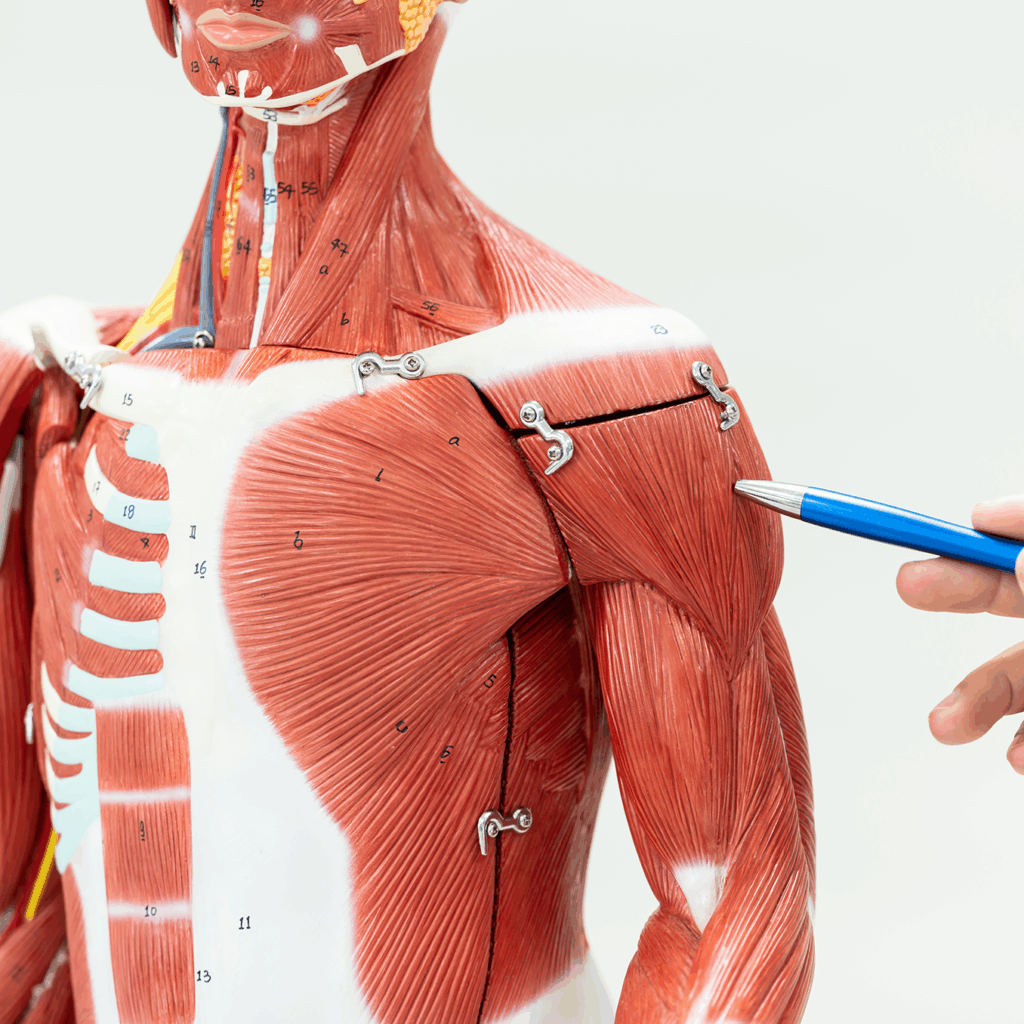
The musculoskeletal system, a diverse network of supportive and specialized connective tissue, makes up a majority of the human body and requires specific nutrients for growth, function, and repair. Care for this body system is especially critical as it facilitates our ability to be mobile and stay active. However, being mobile also means the joints and supporting connective tissues are at risk of injury, localized inflammation, and degradation. Specific nutrients may be especially beneficial for musculoskeletal functionality and support, which this article will dive into below.
The musculoskeletal network includes bone, cartilage, ligaments, tendons, and extracellular matrix which gives the body structure with the ability to move and be mobile. However, given that humans are mobile beings, the musculoskeletal system is highly prone to injury, inflammation, and aging. This ‘wear and tear’ on the musculoskeletal system may then lead to, or exacerbate, chronic pain, obesity, immobility, disability, and other co-morbidities. It is therefore important to heal and strengthen the structural body, prevent future injuries, and help diffuse this physical, mental, and societal burden.
Types of Connective Tissue
When looking at the musculoskeletal system, there are two main categories of connective tissue. This includes specialized tissue, which is essentially the skeletal frame consisting of bone and cartilage, and supportive tissue. Supportive tissue can be further broken down into dense connective tissue and loose connective tissue. Dense connective tissue includes tendons and ligaments, while the extracellular matrix is considered loose connective tissue.1
Bone
Bone is a specialized rigid, structural tissue with a mineralized extracellular component. Aside from being the structural support system of the body, bone is also responsible for protecting the organs, maintaining electrolyte balance, and producing components of blood such as red blood cells, white blood cells, and platelets. Cartilage, also a specialized connective tissue, is comprised of collagen and extracellular matrix, and acts as a shock absorber to protect the terminal end of the bone from frictional damage within the joint.2
Other Connective Tissues
Dense connective tissue is a dense fibrous network of collagen strands, which offers both flexibility and resistance and allows for movement of the structural, skeletal body. Loose connective tissue is a dispersed, spacious matrix of dense fibers and elastin, that creates a malleable casing around muscles, organs, and other tissues.1
Muscle and It’s Relation to Connective Tissue
To better understand loose connective tissue, it is important to also understand the structure of muscle. Muscle is not categorized as connective tissue, rather it is in a category all its own. However, it is a combination of loose connective tissues, muscle cells, nerves, and capillaries working together in an integrated, highly-bundled way.
Tendons
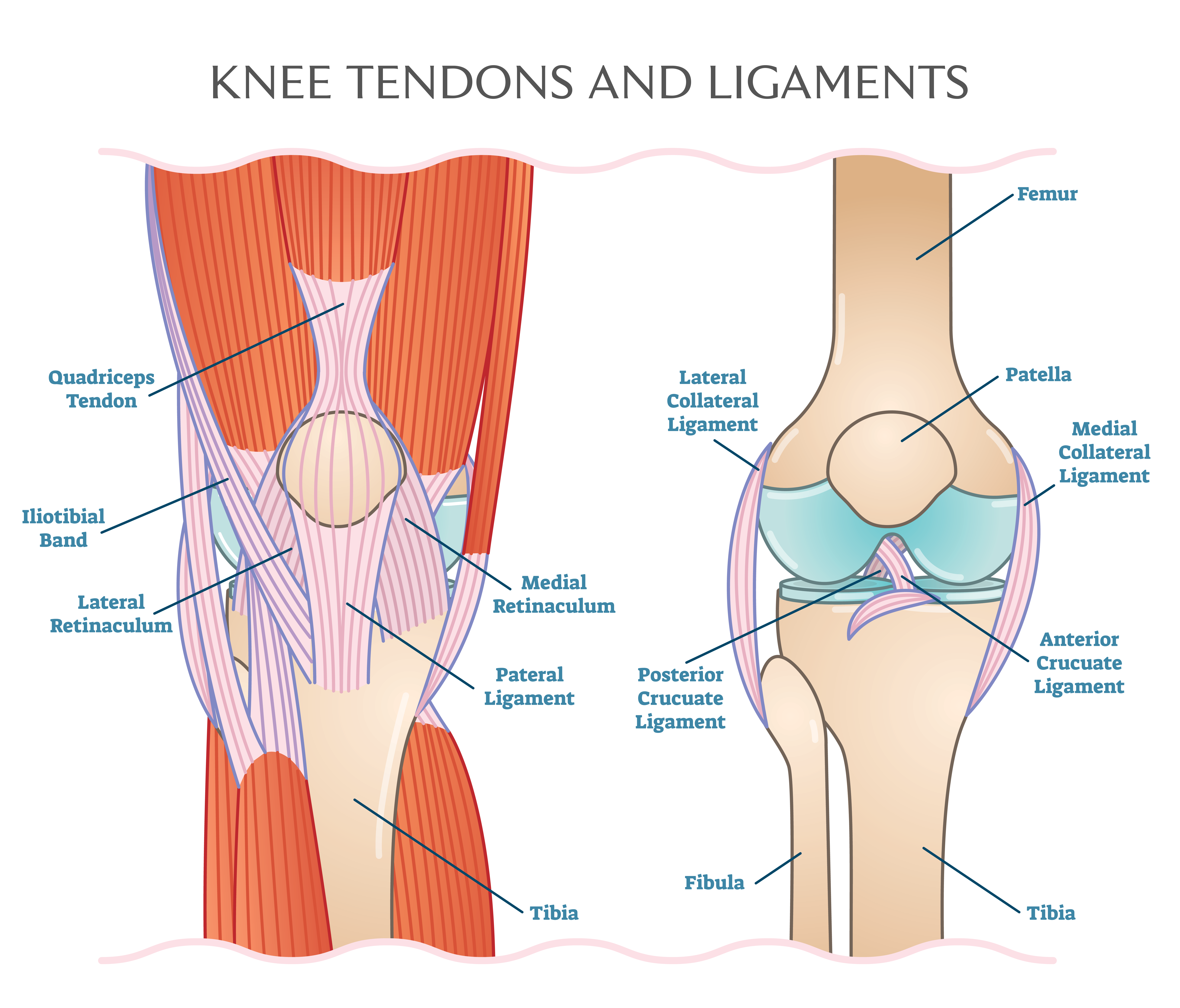
The loose connective tissue in the muscle is a supportive and essential component of the muscle, allowing it to act and function as a cohesive unit. At the terminal ends of the muscle, this loose connective tissue transitions into dense connective tissue and, thus, forms the tendon, making the tendon a seamless continuation of the muscle bundle. The tendon, as part of the muscle, then is attached to the bone which allows the muscle contractions to directly influence the positioning of the bone, which brings about movement and locomotion.1
Ligaments
The other type of dense connective tissue is the ligament. Where tendons are more collagen-fiber based and provide strong tensile strength, ligaments are moreso comprised of elastin, a more flexible, but still structural protein. The ligament also connects bone to bone at the joint, rather than bone to muscle like the tendon, and limits range of motion while mediating joint stability.2-4
Both forms of dense connective tissue, tendons and ligaments as well as cartilage, are also avascular, meaning they do not have their own blood supply, and have to attain nutrients and healing factors from other nearby components such as the extracellular matrix, synovial joint fluid, and the localized vascular supply. With limited blood supply to these tissues, the normal inflammatory healing response does not occur and thus healing is inherently challenged.2,4,5
Conditions of the Musculoskeletal System
As these tissues serve to absorb, dissipate, and transmit forces attributed to movement and mobility, they are also highly prone to injury. Injury can be acute, occurring suddenly or due to a singular stress event, or chronic, due to repetitive overuse, stress, or trauma without the experience of an acute injury.5 Then, depending on the severity, musculoskeletal injury may further lead to chronic pain, physical limitations, comorbidities, and disability.6,7
In addition, the musculoskeletal system may experience inflammation due to injury, conditions of chronic inflammation such as obesity, as well as autoimmune disorders such as Rheumatoid Arthritis. These inflammatory factors have been shown to degrade and weaken the joint, affecting both skeletal muscle and cartilage, and additionally, the cross-linking of collagen in tendons and ligaments. This commonly presents as a decrease in physical strength, range of motion, and mobility, with an increased experience of pain, joint instability, and bone demineralization. This may also present as arthritis, tendonitis, and obesity-induced sarcopenia, or the inflammatory degradation of skeletal muscle which is also striated with fatty deposits.8-10
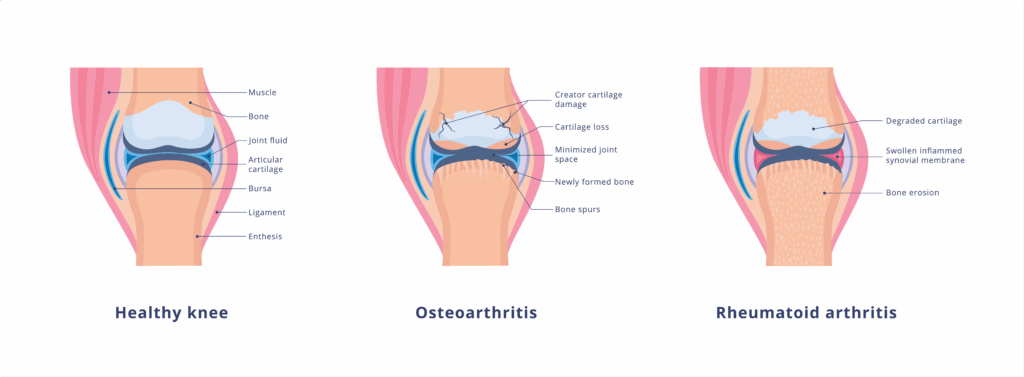
The musculoskeletal system is also susceptible to age-related changes such as the conversion of healthy tissue to more fibrous tissue, tissue degradation, and impaired tissue remodeling and healing.8,11 This often presents as osteoporosis, osteoarthritis, calcification of the cartilage, and age-related sarcopenia.12 It is more prevalent for women to experience age-related connective tissue issues due to the hormonal changes later in life.9 However, while such musculoskeletal disturbances have been well-correlated to aging and hormone changes, the exact mechanisms that predispose the joints to such degradation are not yet well understood.5,10
It is thought that once connective tissue is damaged, it will never return to normal function.5,13,14 With the obvious physical, mental, and economic implications this has on the population, symptom mitigation, healing and recovery, delayed progression, and further prevention are key to ensuring longevity.6,12,15
Nutrition to Support Musculoskeletal Health
Nutrition is essential for proper musculoskeletal development and maintenance as malnutrition has been shown to contribute to poor bone and muscle formation, while childhood obesity has also been shown to augment bone, tendon, cartilage, and muscle growth, specifically in the lower extremities.16,17
Hydration
In looking at nutrition to support the musculoskeletal system, first and foremost, proper hydration is essential as it promotes the elasticity of the connective tissues and also facilitates the delivery of nutrients to these tissues via the blood stream. Tendons in particular benefit from proper hydration as water has been shown to have a direct affect on the elasticity, flexibility, strength, and resilience of these specific connective tissues. Hydration also helps to prevent age-related tissue degradation. 18
Protein
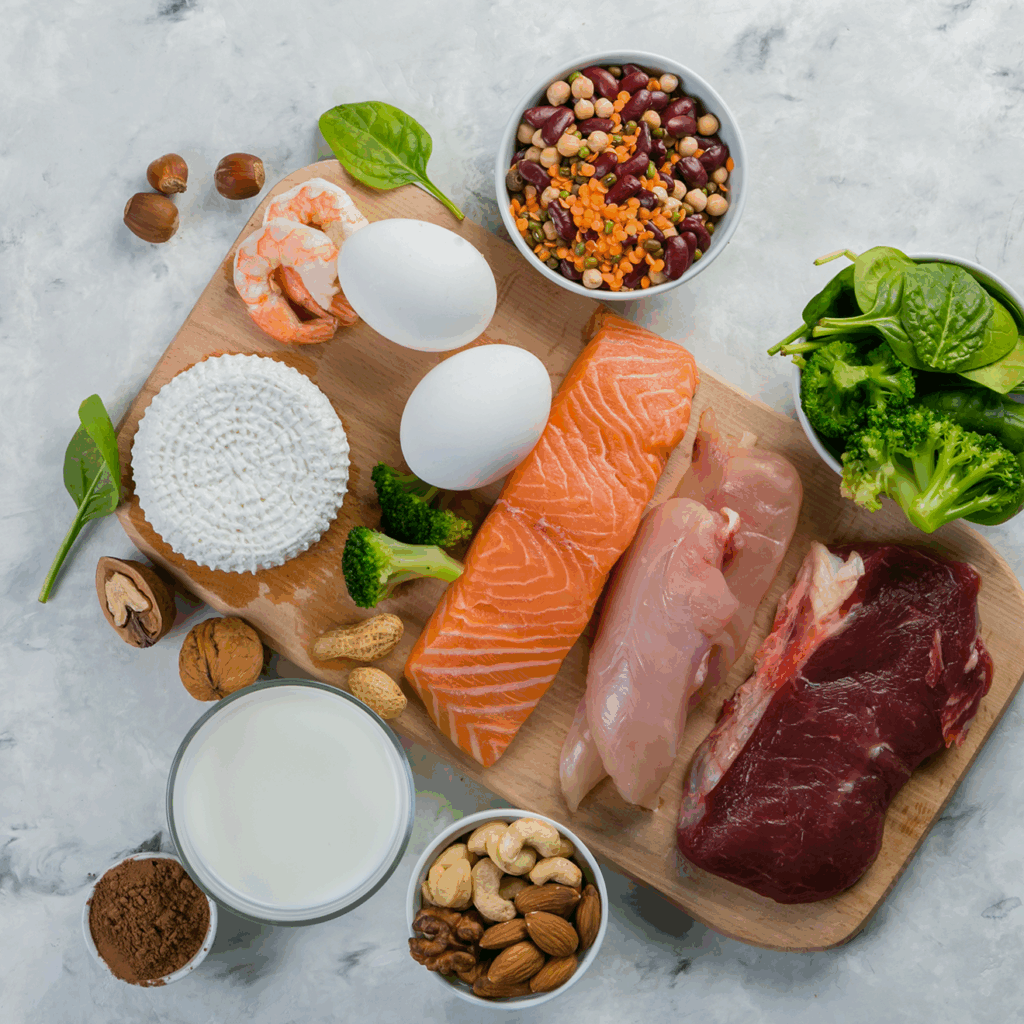
Protein, found in meats, dairy, legumes, and nuts, is also essential for proper growth, maintenance, repair, and health of the connective tissues. It supplies the body with the building blocks for joint repair and maintenance, supports bone formation, bone density, and bone durability, aids in collagen synthesis, enhances resistance and endurance-based exercise, and contributes to muscle mass, physical strength, and muscle mass retention. It also supports healing and repair of the tissues while preventing further degradation.19-21
Calcium
Connective tissues are also heavily reliant on the nutritional intake of various minerals. Calcium in particular, with 99% being contained in the bones (and also found in cruciferous vegetables), is essential for bone-specific development, repair, and remineralization. It has also been shown to work synergistically with protein to further support bone health. However, for proper calcium utilization, phosphorous, as found in meats, dairy, legumes, nuts, and whole grains, is also important as it binds to calcium and supports the (re)mineralization of the skeletal structure.21,22
Magnesium
Magnesium, found in whole grains, dark leafy vegetables, legumes, and nuts, has also been shown to support bone growth, remineralization, and calcium metabolism, where deficiency may present as osteopenia, osteoporosis, and overall bone frailty.22 Magnesium also supports joint preservation and pain mitigation as well as improves the action-potential of the muscle, calms the muscle nerves, and supports peripheral nerve regeneration.19,23
Iron and Zinc
Iron, another mineral that supports the connective tissues, of which is found in meats, leafy green vegetables, legumes, and nuts, specifically supports collagen synthesis and muscle movement. Likewise, zinc, found in meats, whole grains, legumes, and nuts, also supports collagen formation, as well as the developmental growth of bone via hormone modulation. A deficiency in zinc may lead to stinted growth in adolescents and osteoporosis in the aged.22
Trace Minerals: Manganese, Copper, Selenium
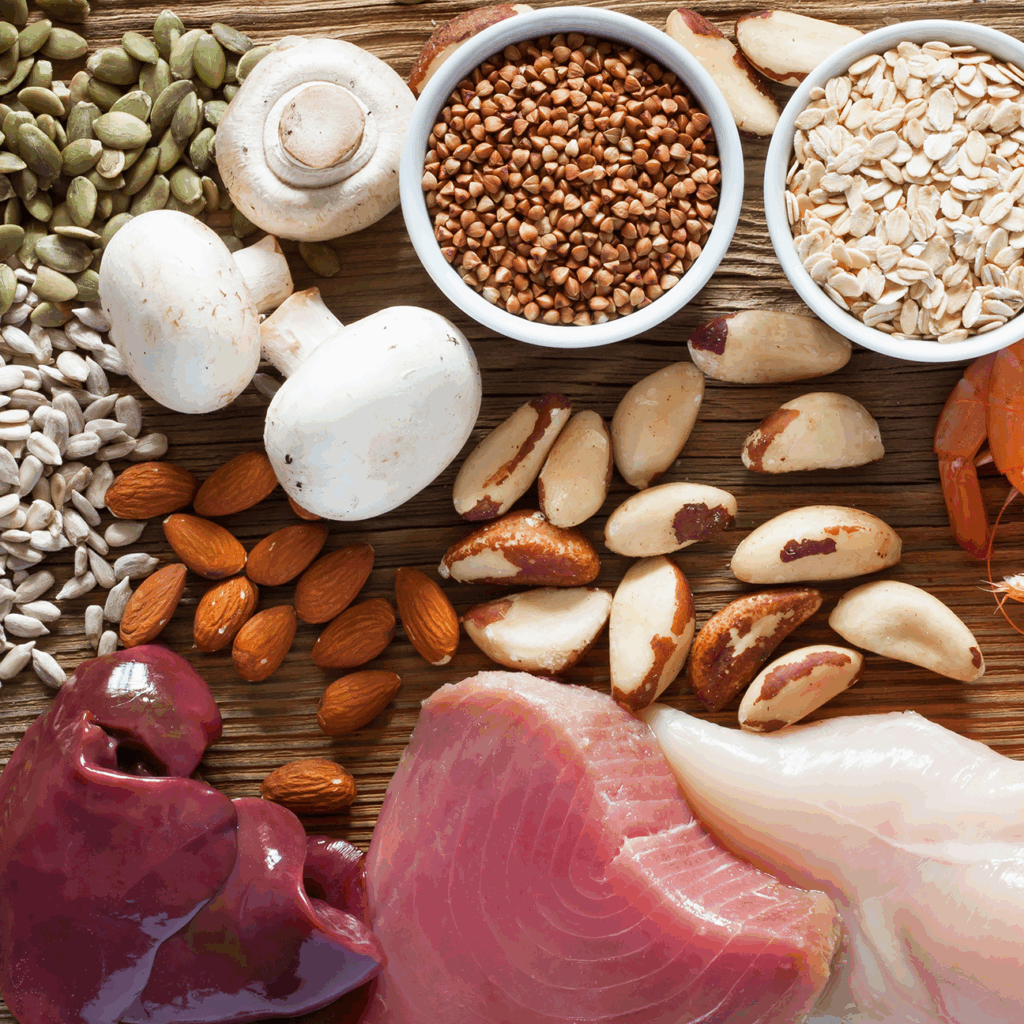
Some additional supportive trace elements include manganese, copper, and selenium. Manganese, found in whole grains, legumes, and nuts, is directly related to the formation of the extracellular matrix, cartilage, and bone, where deficiency has been linked to musculoskeletal tissue degradation.24 Manganese may provide joint-specific support by mediating pain and improving overall functionality of the joint as it is believed to influence the inflammatory response mechanisms of the connective tissue, although this mechanism is not well understood. Additionally, manganese has been shown to be especially supportive during states of injury, osteoporosis, and osteoarthritis.19
Some additional supportive trace elements include manganese, copper, and selenium. Manganese, found in whole grains, legumes, and nuts, is directly related to the formation of the extracellular matrix, cartilage, and bone, where deficiency has been linked to musculoskeletal tissue degradation.24 Manganese may provide joint-specific support by mediating pain and improving overall functionality of the joint as it is believed to influence the inflammatory response mechanisms of the connective tissue, although this mechanism is not well understood. Additionally, manganese has been shown to be especially supportive during states of injury, osteoporosis, and osteoarthritis.19
Copper, found in meats, whole grains, legumes, nuts, and mushrooms, is essential for the proper cross-linking of collagen and has been shown to be beneficial for the repair of dense connective tissue, such as tendons and ligaments.25 Selenium, found in meats, whole grains, root vegetables, nuts, and legumes, plays a specific role in bone, cartilage, and tendon synthesis. Additionally, it is a potent antioxidant and supports a healthy inflammatory response.22
Vitamins A, B12, C, D, E, and K to Support Musculoskeletal Health

In addition to these minerals, there are several vitamins that are beneficial for musculoskeletal health, including the antioxidant vitamins A, C, and E. Vitamin A, found in liver, dairy, fatty fish, and yellow/orange-colored produce, specifically promotes the metabolic pathway of bone maturation, as well as bone mass, and is therefore bone-protective.26,27 It also contributes to collagen synthesis, peripheral nerve regeneration, and further aids in wound/fracture healing and recovery.23
Vitamin A is also critical for the musculoskeletal system as it is one of the key nutrients for cartilage support and has been shown to be protective against arthritis.28 Vitamin C, found in citrus fruits, tropical fruits, and cruciferous vegetables, is essential for collagen formation, and further cross-linking, and is therefore beneficial for both tendon and ligament repair.22,25 It is also required for the synthesis of the bone matrix.21 Then Vitamin E, found in nuts, seeds, fatty fish, and healthy oils, as a potent antioxidant and anti-inflammatory, supports both cartilage and tissue repair, and helps to prevent further degradation.19
Vitamin B12, D, and K also support musculoskeletal health. Vitamin B12, found in meat, eggs, and dairy, has been shown to directly influence homocysteine concentration and is therefore critical to bone formation, bone mineral density, collagen cross-linking, and tendon integrity.29-31 Vitamin D, found naturally in fatty fish, mushrooms, red meat, and eggs, stimulates mineralization of bone, enhances bone reabsorption, affects collagen maturation, and also promotes intestinal absorption of both calcium and phosphorous, thereby impacting the normal body growth and development.22 It has also been shown to promote muscle and peripheral nerve regeneration, and repair following an injury, whereas deficiency has been linked to muscle weakness, muscle fatigue, and sarcopenia.23,25,32 Vitamin K, found in meats, eggs, dark leafy vegetables, nuts, legumes, and fermented foods, supports bone metabolism, bone mineral density, bone strength, and cartilage.21,22
Omega-3 Fatty Acids for a Healthy Inflammatory Response
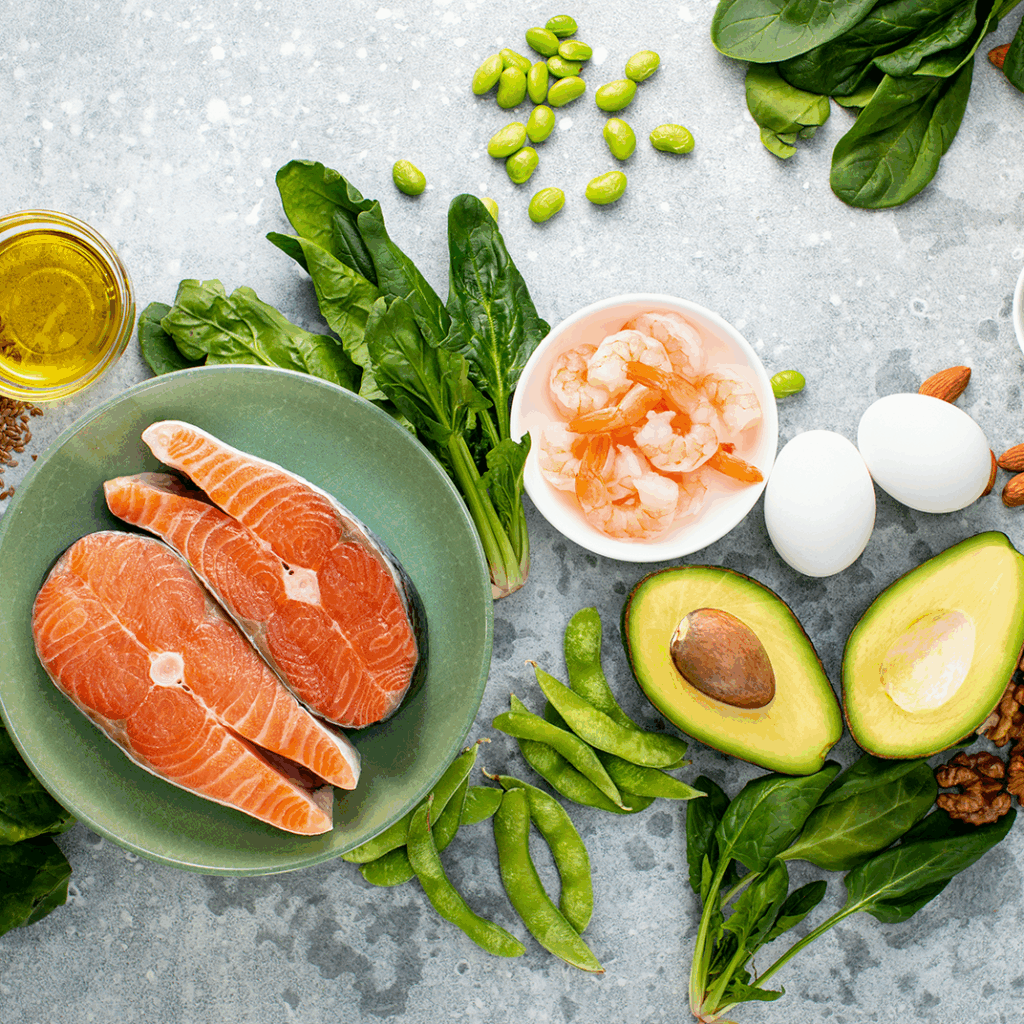
To address joint-specific inflammation, it is important to also consider dietary intake of omega-3 fatty acids. Omega-3 fatty acids, found in fatty fish, have been shown particularly effective in alleviating inflammation, and thus pain, in the joints. They have been shown to be protective against cartilage, collagen, and extracellular matrix degradation, and are particularly beneficial for those with arthritis. Additionally, they have been shown to aid in muscle repair and recovery following injury.19,32,33
Then, to address joint-specific inflammation, it is important to also consider dietary intake of omega-3 fatty acids. Omega-3 fatty acids, found in fatty fish, have been shown particularly effective in alleviating inflammation, and thus pain, in the joints. They have been shown to be protective against cartilage, collagen, and extracellular matrix degradation, and are particularly beneficial for those with arthritis. Additionally, they have been shown to aid in muscle repair and recovery following injury.19,32,33
Turmeric and Boswellia: Herbs to Calm Join Inflammation
Herbs, such as turmeric and boswellia have also been shown to help mitigate connective tissue-specific inflammation. Curcumin, the main constituent in turmeric, has been shown to reduce pain and inflammation of both the joints and the muscles and also supports collagen structure, cellular regeneration, and connective tissue healing.32-34 Similarly, boswellia has specifically been shown effective in reducing muscle, tendon, and joint pain, as well as inflammation.33,34
Additional Support: Peripheral Blood Supply and Nerve Support
As the musculoskeletal system is fully integrated with nerves and peripheral blood supply, it is important to sufficiently support the central nervous system and cardiovascular system as well. B12 also has a neuroprotective effect and also helps to support peripheral nerve regeneration.35,36
Both gotu kola and ginger have long been used to promote circulation and enhance the peripheral blood supply.37 Gotu kola has been used to strengthen the veins and thus improve the microcirculation and resiliency of the capillaries and connective tissue.38 While gingerol, the main constituent in ginger, has specifically been used to improve blood flow to the brain and limbs, mitigate joint inflammation, reduce blood viscosity, and support overall cardiovascular health.37
Clinical Takeaways

A whole foods-based diet focused on healthy, clean sources of fish, nuts, seeds, leafy greens, mushrooms, legumes, whole grains, colorful fruits, and root vegetables goes a long way in nutritionally supporting the musculoskelatal system as a whole. For those who choose not to, or cannot, consume foods such as red meats, organ meats such as liver, dairy, and eggs, whole food based dietary supplements can be a great option to add in the vitamins and minerals those foods offer. Adding in herbs such as turmeric, ginger, gotu kola, and boswelia can help in calming inflammation and supporting healthy circulation.
With the previously mentioned nutrients, the connective tissues, joints, and musculoskeletal system as a whole will be well-taken care of and overall more resilient to injury, aging, and inflammation. While many musculoskeletal conditions may not be reversible, nutritional and herbal interventions may slow further degradation, promote repair and recovery, support movement and locomotion, and mitigate pain and inflammation, thereby facilitating a more enjoyable quality of life.
Did you know WholisticMatters is powered by Standard Process? Learn more about Standard Process’ whole food-based nutrition philosophy.
- Jan. PKGMTCAA. Anatomy: Connective Tisue. StatPearls. StatPearls Publishing; 2023. https://www.ncbi.nlm.nih.gov/books/NBK538534/
- Barbe M, Driban J, Barr A, Popoff S, Safadi F. Structure and Function of Joints. 2009:51-60.
- van der Wal J. The architecture of the connective tissue in the musculoskeletal system-an often overlooked functional parameter as to proprioception in the locomotor apparatus. Int J Ther Massage Bodywork. Dec 7 2009;2(4):9-23. doi:10.3822/ijtmb.v2i4.62
- Juneja P, Munjal A, Hubbard JB. Anatomy, Joints. StatPearls Publishing, Treasure Island (FL); 2025.
- Arendt E, Griffin L. Musculoskeletal injuries. Oxford: Blackwell Science; 2000. p. 37-61.
- Zernicke R, Whiting W. Mechanisms of musculoskeletal injury. Biomechanics in Sport: Performance Enhancement and Injury Prevention. 2000:507-522.
- Molloy JM, Pendergrass TL, Lee IE, Chervak MC, Hauret KG, Rhon DI. Musculoskeletal injuries and United States Army readiness part I: overview of injuries and their strategic impact. Military medicine. 2020;185(9-10):e1461-e1471.
- Collins KH, Herzog W, MacDonald GZ, et al. Obesity, Metabolic Syndrome, and Musculoskeletal Disease: Common Inflammatory Pathways Suggest a Central Role for Loss of Muscle Integrity. Review. Frontiers in Physiology. 2018-February-23 2018;Volume 9 – 2018doi:10.3389/fphys.2018.00112
- Woolf AD, Pfleger B. Burden of major musculoskeletal conditions. Bulletin of the world health organization. 2003;81(9):646-656.
- Loeser RF. Age-related changes in the musculoskeletal system and the development of osteoarthritis. Clinics in geriatric medicine. 2010;26(3):371.
- Alnaqeeb M, Al Zaid N, Goldspink G. Connective tissue changes and physical properties of developing and ageing skeletal muscle. Journal of anatomy. 1984;139(Pt 4):677.
- Li B, Chen D. Degenerative musculoskeletal diseases: pathology and treatments. Journal of orthopaedic translation. 2019;17:1.
- Hamerman D. Aging and the musculoskeletal system. Annals of the rheumatic diseases. 1997;56(10):578-585.
- James R, Girish K, Balian G, Chhabra B. Tendon: Biology, Biomechanics, Repair, Growth Factors, and Evolving Treatment Options. The Journal of hand surgery. 02/01 2008;33:102-12. doi:10.1016/j.jhsa.2007.09.007
- Yoshimoto Y, Oishi Y. Mechanisms of skeletal muscle-tendon development and regeneration/healing as potential therapeutic targets. Pharmacology & Therapeutics. 2023/03/01/ 2023;243:108357. doi:https://doi.org/10.1016/j.pharmthera.2023.108357
- Wearing S, Hennig E, Byrne N, Steele J, Hills A. The impact of childhood obesity on musculoskeletal form. Obesity reviews. 2006;7(2):209-218.
- Watts R, Watts RA, Conaghan P, et al. Oxford textbook of rheumatology. Oxford University Press; 2013.
- Elden HR. Hydration of connective tissue and tendon elasticity. Biochimica et Biophysica Acta (BBA) – Specialized Section on Biophysical Subjects. 1964/05/25/ 1964;79(3):592-599. doi:https://doi.org/10.1016/0926-6577(64)90225-6
- Lavalle S, Scapaticci R, Masiello E, et al. Beyond the Surface: Nutritional Interventions Integrated with Diagnostic Imaging Tools to Target and Preserve Cartilage Integrity: A Narrative Review. Biomedicines. 2025;13(3):570.
- Lewis R, Gómez Álvarez CB, Rayman M, Lanham-New S, Woolf A, Mobasheri A. Strategies for optimising musculoskeletal health in the 21st century. BMC Musculoskeletal Disorders. 2019/04/11 2019;20(1):164. doi:10.1186/s12891-019-2510-7
- Joshi N, Raghuvanshi RS. Nutrients for building strong and healthy bones. 2020;
- Belbase RJ, Raje AD, Singh A. A review on the role of macro and micro nutrients in bone health. International Journal of Research in Orthopaedics. 08/26 2019;5(5):995-999. doi:10.18203/issn.2455-4510.IntJResOrthop20193851
- Dellacava A. Does a positive relationship exist between nutritional supplementation strategies and the body’s ability to regenerate after injury? 2024;
- Dong P-F, Jin C, Lian C-Y, Wang L, Wang Z-Y. Enhanced extracellular matrix degradation in growth plate contributes to manganese deficiency-induced tibial dyschondroplasia in broiler chicks. Biological Trace Element Research. 2022;200(7):3326-3335.
- Close GL, Sale C, Baar K, Bermon S. Nutrition for the Prevention and Treatment of Injuries in Track and Field Athletes. International Journal of Sport Nutrition and Exercise Metabolism. 01 Mar. 2019 2019;29(2):189-197. doi:10.1123/ijsnem.2018-0290
- Yee MMF, Chin KY, Ima-Nirwana S, Wong SK. Vitamin A and Bone Health: A Review on Current Evidence. Molecules. Mar 21 2021;26(6)doi:10.3390/molecules26061757
- Lerner UH. Vitamin A – discovery, metabolism, receptor signaling and effects on bone mass and fracture susceptibility. Front Endocrinol (Lausanne). 2024;15:1298851. doi:10.3389/fendo.2024.1298851
- Si H, Li S, Liu H, et al. Vitamin A Supplementation Induces AMFK Production to Promote Cartilage Proliferation and Antler Growth in Sika Deer. Animals. 2025;15(19):2879. doi:10.3390/ani15192879
- Li K, Guo C, Yin Y, Chen X, Zheng M. Association between dietary vitamin B12 intake and bone mineral density in adolescents. Pediatric Research. 2025/06/02 2025;doi:10.1038/s41390-025-04150-6
- Clements M. Studies of vitamin B12, folate and the metabolically related B-vitamins, and their relationship with bone health, in older adults. 2022;
- Kim JH, Kim GT, Yoon S, et al. Low serum vitamin B(12) levels are associated with degenerative rotator cuff tear. BMC Musculoskelet Disord. Apr 17 2021;22(1):364. doi:10.1186/s12891-021-04231-7
- Heaton LE, Davis JK, Rawson ES, et al. Selected in-season nutritional strategies to enhance recovery for team sport athletes: a practical overview. Sports medicine. 2017;47(11):2201-2218.
- Motion Hi. Nutritional Supplements for Joint Health. 2023. https://healinginmotion.org/tag/nutritional-supplements/
- Nikolaeva TI, Laurinavichus KS, Molchanov MV, Kuznetsova SM, Emelyanenko VI, Shekhovtsov PV. Complex of Collagen Peptides and Glycosaminoglycans: Prevention and Treatment of Diseases of the Musculoskeletal System. Biology Bulletin Reviews. 2024/12/01 2024;14(3):S219-S232. doi:10.1134/S2079086424600449
- Wu F, Xu K, Liu L, et al. Vitamin B12 Enhances Nerve Repair and Improves Functional Recovery After Traumatic Brain Injury by Inhibiting ER Stress-Induced Neuron Injury. Original Research. Frontiers in Pharmacology. 2019-April-24 2019;Volume 10 – 2019doi:10.3389/fphar.2019.00406
- Julian T, Syeed R, Glascow N, Angelopoulou E, Zis P. B12 as a Treatment for Peripheral Neuropathic Pain: A Systematic Review. Nutrients. 2020;12(8):2221.
- Stansbury J. Herbal Formularies for Health Professionals, Volume 2: Circulation and Respiration, including the Cardiovascular, Peripheral Vascular, Pulmonary, and Respiratory Systems. vol 2. Chelsea Green Publishing; 2018.
- Gohil KJ, Patel Ja Fau – Gajjar AK, Gajjar AK. Pharmacological Review on Centella asiatica: A Potential Herbal Cure-all. (1998-3743 (Electronic))
